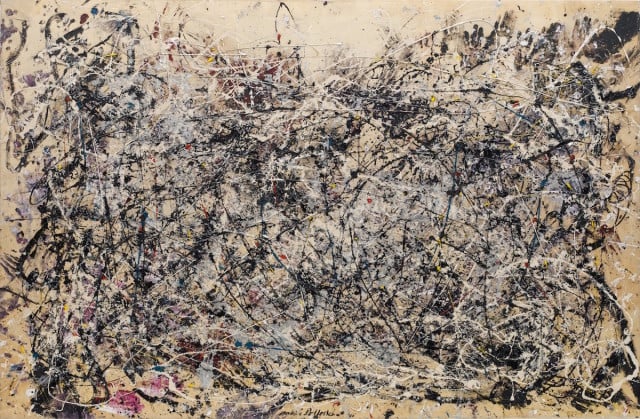
THE DAILY PIC (#1494): “It would make a most enchanting printed silk,” said Sir Leigh Ashton, director of the Victoria and Albert Museum. Theodore Greene, Professor of Philosophy at Yale, said it reminded him of “a pleasant design for a necktie” while Aldous Huxley, the illustrious author, said “it seems to me like a panel for a wallpaper.” These august personages were convened for a Life magazine round table on art in October of 1948, and the picture they were commenting on was a recent Jackson Pollock – similar to this painting called Number 1A, 1948 that’s in MoMA’s current survey of its Pollock holdings, about which I’ve been writing all week.
If Life’s three sages weren’t just talking in the most general terms, it seems that a bunch of modern textile designers must have come to Pollock’s alloverisms before he did – so much so that their products instantly sprang to mind for three quite conservative men. Here’s one textile I was able to find that may have been the kind of thing the Lifemen were thinking of:
It was designed in England before 1944 (well before Pollock had hit his stride, that is) and then silkscreened onto silk yardage by John Heathcoat & Co. in around 1946.
That gives it an automatic connection to the Pollock silkscreens that I discussed on Tuesday: Silkscreening’s roots in textiles helped give the technique its democratic aura. And it brings my week of Pollock-ing full circle, to the claims I was making Monday about the artist’s well-camouflaged links to the “feminine” and the world of women’s work.
Abstract Expressionism may have billed itself as the purest of pure art, an upwelling direct from the artist’s soul and psyche, but it’s no surprise to find that it had roots deep in the world and moment it came out of. And maybe in its fabric stores. (© 2016 Pollock-Krasner Foundation / Artists Rights Society (ARS), New York)
See ‘Related Stories’ below for the whole Pollock series, and for a full survey of past Daily Pics visit blakegopnik.com/archive.